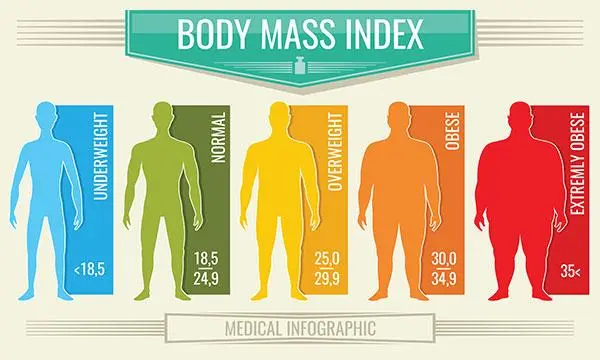BMI Calculator – Check Your Body Mass Index For Women & Men

Image: Shutterstock
The BMI calculator is a valuable tool that helps assess body composition by evaluating the relationship between a person’s height and weight. This evaluation helps determine if an individual is underweight, of normal weight, overweight, or obese. It widely describes whether you are in a healthy zone or need to lose or gain weight. BMI ranges may vary based on your exercise regime. The more you gain weight the more your BMI increases but this does not mean that you are obese. An increase in BMI can also be because of high muscle mass.

In This Article
Results
--------------------------------------------------------------------------------------- - - - - - - -
Obese
Overweight
Normal
Underweight
Based on the height and weight entered, your BMI is indicating your weight is in the Category for adults. For your height,a normal weight range would be from to
What Is Body Mass Index?
BMI is Body Mass Index a parameter to assess nutritional status as per
height and weight. It is a ratio between weight in kilograms and height in
square meters (1).
BMI chart Adults

Standard BMI ranges and nutritional status as per WHO
| BMI | Weight Status |
|---|---|
| Below 18.5 | Underweight |
| 18.5 – 24.9 | Normal weight |
| 25.0–29.9 | Pre-obesity |
| 30.0–34.9 | Obesity class I |
| 35.0–39.9 | Obesity class II |
| Above 40 | Obesity class III |
BMI chart Kids
BMI for age percentile is basically designed to assess growth pattern of children and teenage
| Weight Status Category | Percentile Range |
|---|---|
| Underweight | Less than the 5th percentile |
| Normal or Healthy Weight | 5th percentile to less than the 85th percentile |
| Overweight | 85th to less than the 95th percentile |
| Obese | Equal to or greater than the 95th percentile |
How to calculate body mass index?
In Metric Scale
Step 1: Measure your weight in kg preferably in an empty stomach to get actual weight.
Step 2: Measure height by Stadiometer and convert it to meter by dividing it by 100.
In Imperial Scale
Step 1: Measure weight in pounds by digital weighing machine.
Step 2: Multiply height in inches inself.
Step 3: Divide weight and height, results should be multiplied by 703.
Metric BMI Formula:BMI = Weight (kg) ÷ Height 2 (meter 2 )
Imperial BMI Formula:
BMI = Weight (lb) ÷ height 2 (in 2 ) × 703
Risks of being overweight?
Overweight or severely obesity increases the risk of many diseases as per Postgraduate Medicine review studies :
- Diabetes
- Cardiovascular disorders
- Metabolic Syndrome
- High Blood Pressure
- Pancreatitis
- Gallbladder diseases
- Sleep Apnea and breathing problem
- Osteoarthritis
- Non Alcoholic Fatty Liver diseases
- Pulmonary Complications
- Depression
- Low Quality of life
- Increased risk of certain cancers, such as breast, colon, and endometrial cancers.
Risks for being underweight?
Being underweight multiple risks are associated with it:
- Malnutrition
- Low Bone Mineral Density
- Poor Immune System
- Retarded or stunted growth and development among children.
- Hormonal imbalance especially among women
Limitations of BMI
BMI is not an accurate measure when it comes to analyse body fat
- BMI measures overall nutritional status in relation to height and weight. No mention of body fat percentage or muscle mass.
- It does not distinguish water weight, bone mass etc.
- It is not specific to sex of a person. For eg: BMI of male and female is same whereas male has more muscle mass and female has more of fat mass which is not mentioned in BMI chart
What is a healthy BMI for women?
BMI varies as per age, height and weight. It is invariable in respect to gender. Though women have more fat mass compared to men but it does not affect BMI and no scientific evidence mentioned specific BMI for women.
References
Articles on StyleCraze are backed by verified information from peer-reviewed and academic research papers, reputed organizations, research institutions, and medical associations to ensure accuracy and relevance. Read our editorial policy to learn more.
- About child and teen BMI, Centers for Disease Control and Prevention.
https://www.cdc.gov/healthyweight/assessing/bmi/childrens_bmi/about_childrens_bmi.html - Body Mass Index- BMI, World Health Organization, Europe.
https://www.who.int/europe/health-topics/nutrition - The Medical Risks of Obesity, Postgraduate medicine, U.S. National Library of Medicine, National Institutes of Health.
https://www.ncbi.nlm.nih.gov/pmc/articles/PMC2879283/ - Body Mass Index: Considerations for Practitioners, Centers for Disease Control and Prevention.
https://www.cdc.gov/healthyweight/assessing/bmi/index.html
Frequently Asked Questions
What is the best BMI for a senior woman?
A BMI between 25-27 is ideal for older women. However, the number may vary from person to person depending on their height and age.
How do I calculate my BMI in pounds?
BMI= (weight in pounds / (height in pounds) squared) X 703 (conversion factor)
Divide your weight (in pounds) by the squared amount of your height (in pounds). Then multiply that amount by 703 (the conversion factor). This will give you your BMI value in pounds.
Read full bio of Gabrielle Kane
Read full bio of Payal Karnik
Read full bio of Arshiya Syeda
Read full bio of Himanshi Mahajan





Community Experiences
Join the conversation and become a part of our empowering community! Share your stories, experiences, and insights to connect with other beauty, lifestyle, and health enthusiasts.